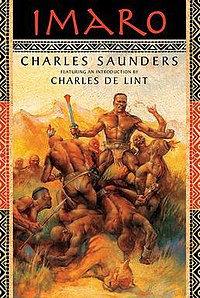Four books this month. Two fiction and two non-fiction.
Imaro by George Saunders (Night Shade Books, 2006)
Imaro is a sword and sorcery adventure based on Africa and African traditions and legends. At the start, the main character Imaro is a young boy struggling to fit in with his people. He faces bullies and then a lion, evil sorcerers, and creepy monsters. He becomes a fierce warrior but he remains an outsider no matter where he goes.
I like how the chapters progress and tie into each other, something that becomes more apparent towards the end. Although the chapters were originally written as short stories, they move a larger story forward. Yes, he’s taller, stronger, and a better fighter than everyone else, but every time he finds some form of happiness, something gets in his way.
I’m interested in languages so I liked the use of Swahili vocabulary, which I think helped create a unique setting. On the other hand, so many terms were used so often it felt a little overwhelming at first. Luckily there’s a glossary in the back.
I read the 2006 updated edition from Night Shade Books. I’m looking forward to reading the other volumes, especially since this volume ends on a cliffhanger.
In a Lonely Place by Karl Edward Wagner (Valancourt Books, 2023)
I’m a big fan of Karl Edward Wagner’s Kane sword and sorcery stories. I’ve been interested in reading his horror fiction but most of his collections are out of print and go for ridiculously high prices. Luckily Valancourt Books put out a new edition of his 1983 collection In a Lonely Place. It includes the story “Sticks,” a Cthulhu Mythos story which is believed to have influenced the 1999 film The Blair Witch Project. I don’t care much for the film but the story is outstanding. So are the rest of the stories. Wagner was a master of atmosphere, tension, and powerful endings, and I liked how a number of these stories are set in the Southern United States. This new edition includes one extra story, “More Sinned Against.”
Non-fiction:
Supernatural Horror in Literature by H. P. Lovecraft (Dover Publications, 1973)
This is an excellent overview, analysis, and criticism of gothic literature, weird fiction, and horror, originally written in 1927.
Quite a few authors are covered including Ambrose Bierce, Nathaniel Hawthorne, and Edgar Allan Poe, who receives his own chapter. In the final chapter on “modern masters,” he discusses Algernon Blackwood, Lord Dunsany, M. R. James, and Arthur Machen.
A must read for anyone interested in weird fiction. Just be aware that Lovecraft goes into great detail regarding the plots of many of the works he discusses.
The Road to Unfreedom by Timothy Snyder (Tim Duggan Books, 2018)
In this book historian Timothy Snyder analyzes events in Russia, Europe, and the United States from 2011 to 2016 in great detail. Some of the things he covers are Putin’s rise to power, the writings of philosopher Ivan Ilyin, leadership changes in Ukraine, the Maidan revolution, how propaganda and disinformation campaigns were used during the annexation of Crimea as well as afterwards, and the US presidential election campaign of 2016.
Recommended reading if you are at all interested in the history of Ukraine and what’s currently happening in Ukraine and in the United States, even if you may not agree with every one of Snyder’s conclusions.
The following quotes about Russia really stood out to me as I feel they could also be referring to current events in the US.
“If citizens doubt everything, they cannot see alternative models beyond Russia’s borders, cannot carry out sensible discussions about reform, and cannot trust one another enough to organize for political change. A plausible future requires a factual present.”
“If citizens can be kept uncertain by the regular manufacture of crises, their emotions can be managed and directed.”





